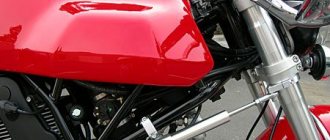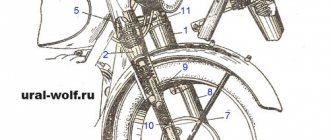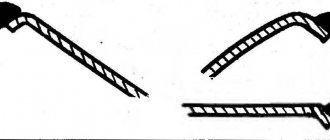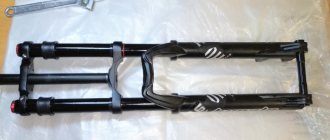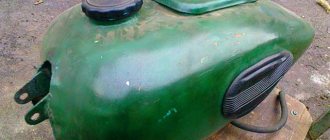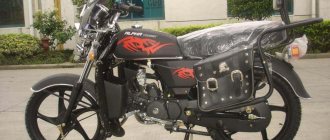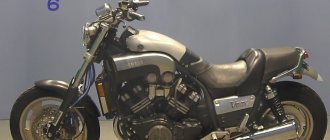motorcycle strangers
The helical spring was invented around the 15th century and was used in watch movements. One of its properties was the accumulation and absorption of mechanical energy. And this is exactly what was required for vehicles. Road irregularities greatly complicated movement and tired the driver. One of the earliest versions of bicycle suspension used a spring, such as the 1891 patent and bicycles with different fork designs.
So the use of similar suspensions on motorcycles was quite logical. Below is an example of another spring suspension on a 1907 motorcycle.
Springer
Gradually the design was improved and the same Springer appeared that can be seen today. Spring is translated as “spring”, which is a shock-absorbing element. Springer is an early type of swingarm short-link fork. This design consists of two parallel forks. One (rear) is rigidly attached to the motorcycle, while the front is movable. The lower ends of the forks are connected by movable rockers, the upper part of the movable fork is connected to the upper part of the fixed fork through springs, shock absorbers, or a combination of springs and shock absorbers. The shock absorber helps smooth out vibrations and harmonic vibrations. Traverses are usually integrated, i.e. welded. This fork is quite simple to manufacture, not very demanding on maintenance, all components are easily accessible and visible. Springers were installed on Harley motorcycles until 1949, when the Hydra Glide model appeared. However, not everyone could afford to get a fresh Harley, and customizers puzzled over the design of their creations. The boom of chopper and bobber buildings gave a second life: old springers were bought at a showdown, pulled out of landfills and digested. Some lengthened them to unprecedented sizes (there were examples of 72″), while others limited themselves to the stock length.
Most often, such forks are used because of their appearance and in cases where the rake is more than 35 degrees. The stroke of the rocker arms is practically independent of the length of the pipes, and the overall rigidity of the structure allows the use of very long forks. Telescopic forks of the same length will not absorb shock - rather, it will be a break job. In addition, springer is lighter.
Lever forks are one way to adjust the trail. In the late 60s and early 70s, customizers installed 12-inch rocker arms (levers that connect the support tubes to the wheel axle) to keep the trail within a reasonable limit when the fork was heavily loaded.
However, despite its advantages, the springer absorbs worse than a telescopic fork. Therefore, the designers installed a “thick” 16″ front wheel, which absorbed small bumps. But old-school lovers cannot be lured by high technology, and in 1988 the HD FXSTS Springer model was introduced
In 1997, the Heritage Springer arrived with the “classic look” of deep fenders, 16″ front wheel, fringed saddlebags, old school horn and tombstone brake light. We can say that this is an updated Knuckle and Panhead.
In 2000, the motorcycle received a new TwinCam88B engine. In 2003, production of the FLSTS/FLSTSI Heritage Springer was discontinued, rumored to be due to the fact that the steering column bearings quickly became unusable. It was recommended to lubricate the bearings every 4000 km.
By the 2005 model year, the shortcomings were eliminated and the FLSTSC Softail Springer Classic was released. its release was completed in 2006.
Softail Springer Classic 2006 and FL 1948 - find 10 differences
